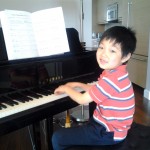Piano practice review with Dina Volkova:
Click to listen to:
 01 Rachmaninoff – Prelude in C-sharp minor Konstantin, piano (class of Dina Volkova)
01 Rachmaninoff – Prelude in C-sharp minor Konstantin, piano (class of Dina Volkova)
There are a few main challenges in this piece we have been working on: image, massive texture and technical difficulties associated with it, sophisticated “quater” pedal and tempo.
Now a little bit more detailed on each of them:
Although Rachmaninoff never told anyone about a program of this Prelude and what he had in mind writing it, any performer has to find an image for this music to be able to understand and consequently to play it better. It is not easy to find a right image of the Prelude, but we agreed that it could be a funeral march (no wonder somebody said it sounds as “someone has been buried alive”!!). The prelude opens with a slow descending three note motif at fortissimo which introduces the grim C-sharp minor tonality that dominates the piece. In the third measure, the volume changes to a pianissimo and the six sounds chords set a tempo of a measured tread. The motif of the opening repeats almost everywhere in the piece, therefore, it has to be heard throughout. I would suggest to segregate the sound of the motif with the sound of the chords by making the motif notes sound “cold” as an inanimate beginning.
The recapitulation of the mail theme represents the theme in four staves to accommodate the volume of triple forte. The quadrupled texture of the recapitulation requires not only exaggerated lateral movement across the keyboard, but also “all the force the player is capable of” (Rachmaninoff). A performer encounters here a problem of playing these “thundering chords” with “all the force” and at the same time without banging on the keys. This section has to be played using the “arm weight method”. Simply let your hands drop chords on the keys by the gravity and weight of your arms. Wrists and elbows have to flex slightly to take the shock of landing. All upper muscles have to relax immediately after each chord. It is very important not to stiffen the arms after because it will transfer the entire arm weight to the keys and simply add force. A performer`s muscles have to be relaxed without any tenseness or unnecessary forces at all times. This way of playing will produce a pleasant, deep tone.
The middle section of the Prelude needs a special attention of a performer. It begins with highly chromatic triplets which are difficult to play because of the highlighted upper voice and increased tempo (Agitato). A pianist would have to practice right hand in a slow tempo holding down the melodic voice. Such practice will require a very close to the keys and strong (but not punchy!) touch so the muscle memory can remember its way through these highly chromatic phrases.
Now a few words about the pedal. There are a few spots in this Prelude where the base notes in the left hand have to be sustained for a long time. For example, in measure 7 (also mm. 11, 15, 28, 29, 32, 33, 50,54), the base note has to last for about 4 beats and there is no way to hold it physically since both hands are involved in playing chords above this base. A performer can use a pedal to hold the base note throughout, but there is a danger to either loose the base note or get a messy sound unless a performer uses the so-called “quater pedal” technique. This means a pianist has to take the base note on the pedal and then make a quater (not full!!) changes on each new chord of the phrase. This way the base note gets sustained and wouldn`t interfere with the constantly changing harmonies above.
Now about the tempo.
As I already said everything in the Prelude makes you think of the slow march. Once we found a right image of the piece it became clear what tempo to choose. Another words the tempo (and other agogics by the way) was driven by the image of the Prelude. Here is a bright example of it. The last few measures of the Prelude, the so called Coda, are about a Russian bell, the sound of which was so much loved by the composer. It is easy to hear how bell rings six times before it eventually stops. To make it work effectively a performer needs to feel a slow measured motion of a big bell and how it slows down by itself at the end of the piece delaying and making each “ring” softer.







